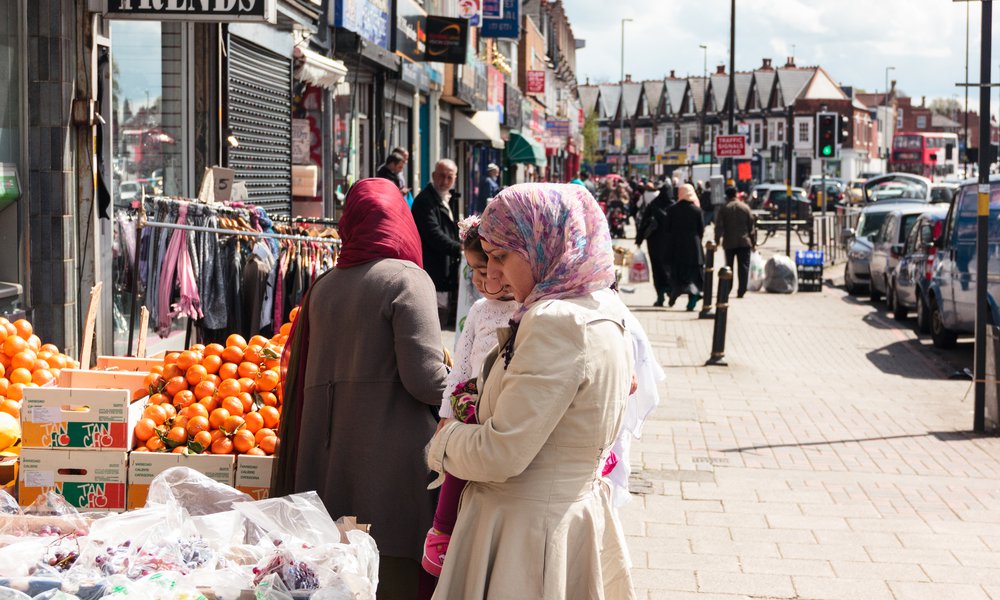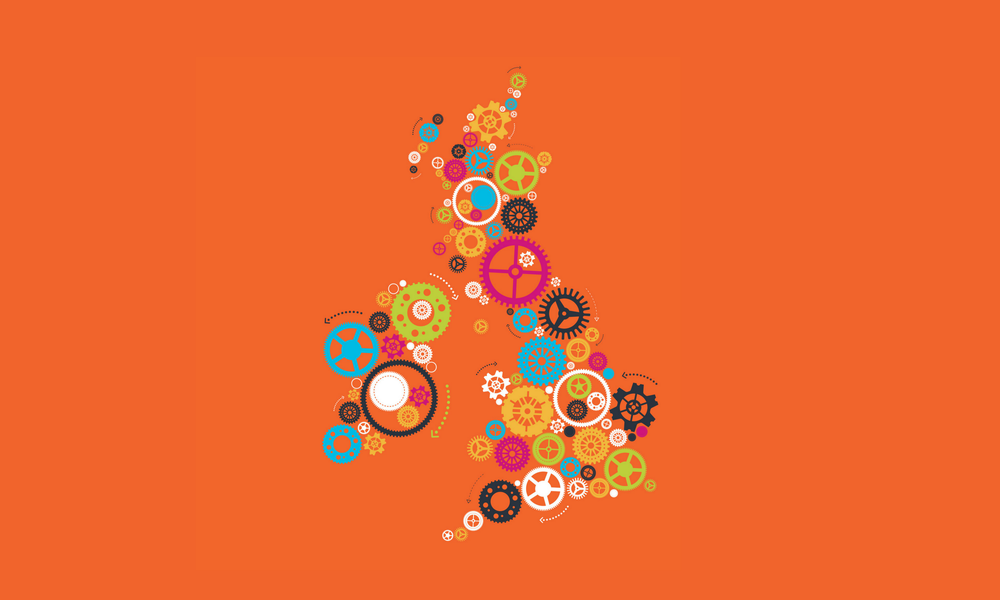“Two Nations”? Brexit, inequality and social cohesion
by Dr Lindsay Richards and Professor Anthony Heath
6 Jun 2017
The referendum back in June last year and the Brexit-related rhetoric since seem to suggest a nation divided in two… just like the famous Two Nations Speech in Disraeli’s 1845 novel Sybil.
“Two nations between whom there is no intercourse and no sympathy; who are as ignorant of each other's habits, thoughts, and feelings, as if they were … inhabitants of different planets”.
The young stranger in the novel was talking about the rich and the poor whereas since the Brexit vote the rhetoric has been more of winners and losers and ‘the left behind’. Have the politics of Brexit brought to the fore some ancient but fundamental rift in British Society?
An alternative line of reasoning, following The Spirit Level, would suggest that the crisis in social cohesion in Britain is a direct result of economic inequality which in Britain worsened in the Thatcher years, then levelled off. It is worth reiterating that Wilkinson and Pickett’s contention in the Spirit Level (more prominent in Wilkinson’s earlier book) is that income inequality is harmful because of its influence on social cohesion.
But what are we really talking about here? Social cohesion is, after all, rather a nebulous concept (though see the OECD definition here). It is possible to think about it in different ways. Brexit-related beliefs and attitudes, firstly, might be an indicator of cohesion because they reveal the extent to which we are a society divided along socio-economic lines in terms of the way we think. This approach also taps into the idea that our values can play a unifying role. It won’t be a surprise to see (in Figure 1) that professionals are more likely to be pro-immigration than the working classes who also feel more of a sense of grievance when comparing how they get treated to the way immigrants are treated. It was also often suggested by commentators that the vote for Brexit was in part an anti-establishment voice and we see here class differences in the sense of being neglected by the political elites in Westminster. (We don’t show it here, but these gradients look similar with income or education which are both strongly related to class).
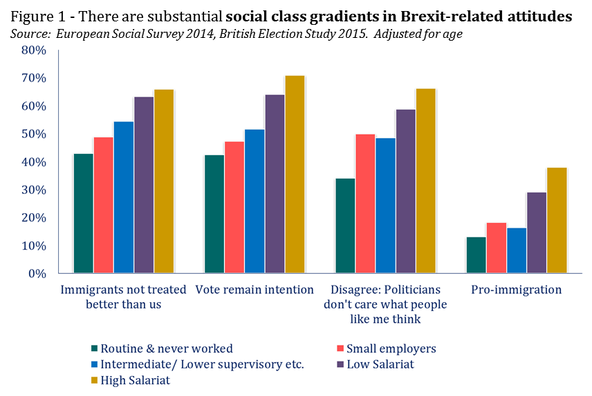
However, while this is certainly a picture of a society differentiated along class lines, it does not necessarily show a polarized society divided into two camps. The language of “two nations” (remainers/ leavers) implies a sharp distinction into two opposing camps but the reality is somewhat different: we do not just see differences between the top and the bottom but gradations in between.
And was Disraeli right to emphasize the lack of intercourse and sympathy between the rich and the poor? A central tenet of recent work in social psychology is that contact between people belonging to different groups will tend to reduce the prejudice that they exhibit towards each other. This idea is more often applied to racial prejudice, but it works on economic inequality too. People are more likely to support redistribution of wealth if their social environment includes poorer people, for example, and we dare say that Brexit would feel less divisive if people’s social networks contained a more even mix of leavers and remainers.
This is the second way we can try to measure social cohesion. Figure 2 shows that these ‘bridging’ or ‘long distance’ friendships crossing class lines are relatively rare in contemporary Britain; less than 20 per cent of routine workers have a friend who is a bank manager, solicitor or lecturer, for example, whereas over 50 per cent of people in the professional or managerial class have such a friend. Short-distance contacts, on the other hand, are more common. There is very little difference, as we move up the class hierarchy, in the chances of having a friend who is a nurse or shop assistant. It follows that such intermediate occupations can serve to bridge the class divide. Socially, Britain is not divided into two opposing tribes. There is a much more blurred picture.
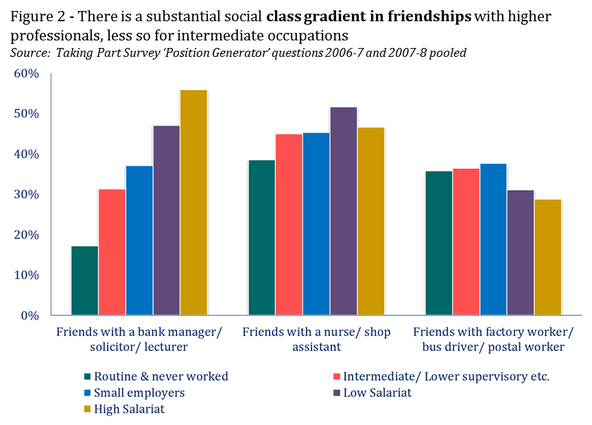
Another way of thinking about social cohesion is in terms of a shared identity which can be a source of ‘social glue’ promoting a sense of responsibility to one’s fellow-citizens. To be sure, nationalism can also be a source of insider/outsider distinctions too and some scholars have linked nationalistic feelings to anti-immigrant dispositions. But whatever you think of it, it’s clear that the socio-economic differences which were so evident in the case of Brexit attitudes and social ties are very much reduced here (see Figure 3).
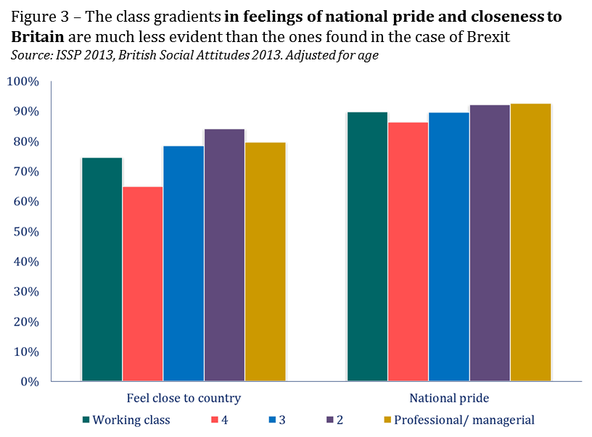
But has our cohesion been corroded by the rising inequality of the 1980s? We do not have good long-term data on all these aspects of cohesion but we do have enough to obtain a reasonably clear indication on some of our measures. In Figure 4 we can see that it is far from a new phenomenon for people in lower socioeconomic positions to feel neglected by Westminster and the class divide in attitudes towards immigration and Europe were already present long before economic inequality began to rise (and long before Brexit was a word).
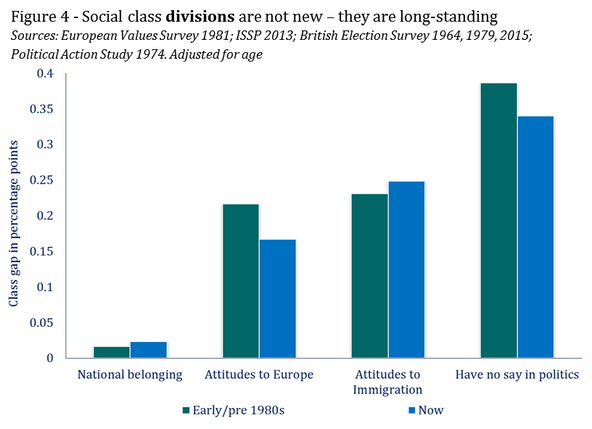
We do not want to draw overly strong conclusions about the extent of change, but there can be no doubt that the highest and lowest strata in Britain were pretty divided in these respects forty years ago. The Brexit question probably did bring old divisions bubbling up to the surface. The increasing economic inequality of the 1980s may have made matters worse, but we should not romanticize the pre-Thatcher era. We should also not over-estimate the extent of divisions in British society – class clearly matters, but we are not quite “two nations”.
This blog post is based on research for a forthcoming book by the Centre for Social Investigation. You can sign-up for our newsletter here or follow us on Twitter @csinuffield.
